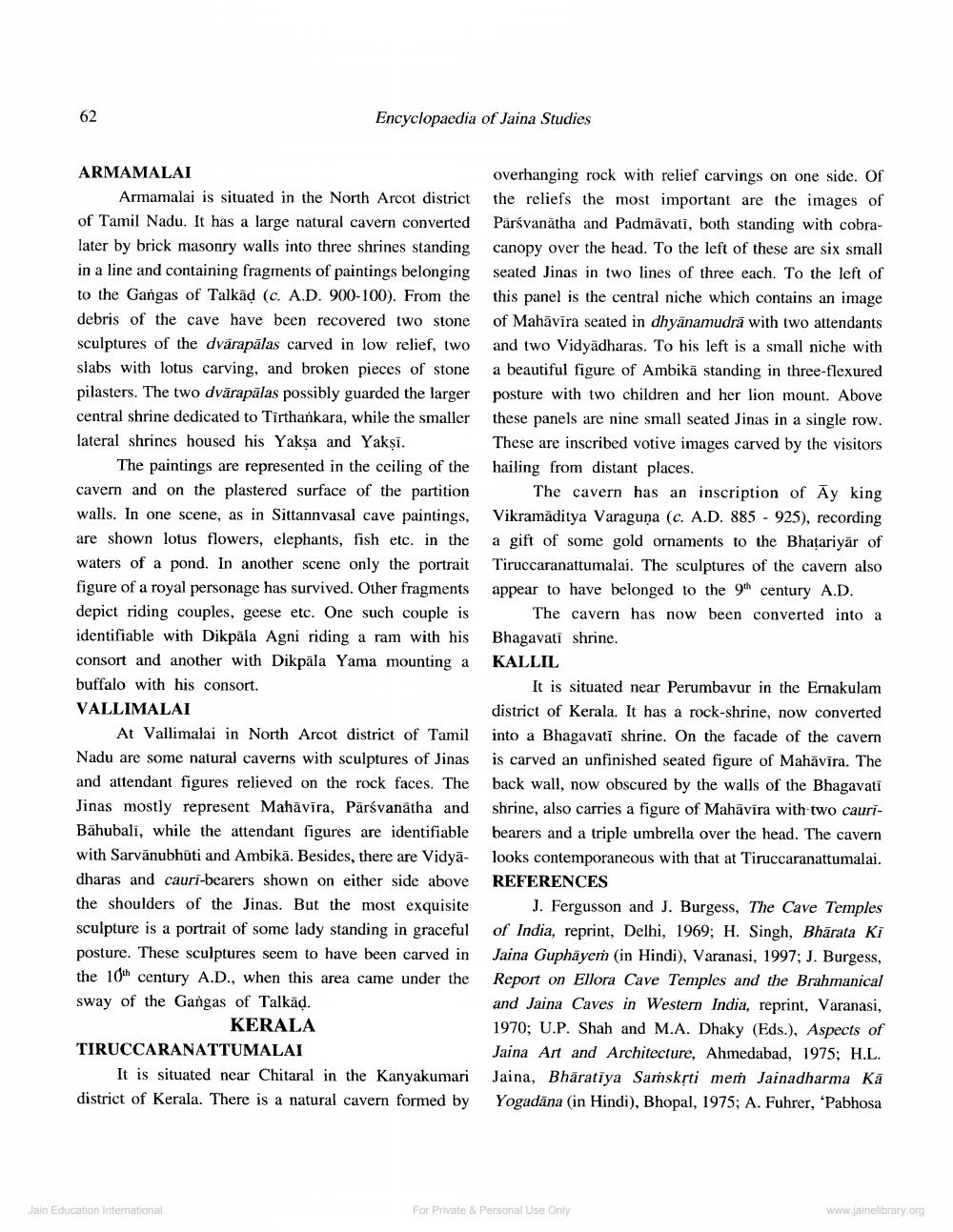________________
62
Encyclopaedia of Jaina Studies
ARMAMALAI
Armamalai is situated in the North Arcot district of Tamil Nadu. It has a large natural cavern converted later by brick masonry walls into three shrines standing in a line and containing fragments of paintings belonging to the Gangas of Talkád (c. A.D. 900-100). From the debris of the cave have been recovered two stone sculptures of the dvārapālas carved in low relief, two slabs with lotus carving, and broken pieces of stone pilasters. The two dvärapālas possibly guarded the larger central shrine dedicated to Tirthankara, while the smaller lateral shrines housed his Yaksa and Yaksi.
The paintings are represented in the ceiling of the cavern and on the plastered surface of the partition walls. In one scene, as in Sittannvasal cave paintings, are shown lotus flowers, elephants, fish etc. in the waters of a pond. In another scene only the portrait figure of a royal personage has survived. Other fragments depict riding couples, geese etc. One such couple is identifiable with Dikpala Agni riding a ram with his consort and another with Dikpāla Yama mounting a buffalo with his consort. VALLIMALAI
At Vallimalai in North Arcot district of Tamil Nadu are some natural caverns with sculptures of Jinas and attendant figures relieved on the rock faces. The Jinas mostly represent Mahāvīra, Pārsvanātha and Bahubali, while the attendant figures are identifiable with Sarvānubhüti and Ambikā. Besides, there are Vidyā- dharas and cauri-bearers shown on either side above the shoulders of the Jinas. But the most exquisite sculpture is a portrait of some lady standing in graceful posture. These sculptures seem to have been carved in the 10th century A.D., when this area came under the sway of the Gangas of Talkād.
KERALA TIRUCCARANATTUMALAI
It is situated near Chitaral in the Kanyakumari district of Kerala. There is a natural cavern formed by
overhanging rock with relief carvings on one side. Of the reliefs the most important are the images of Parsvanatha and Padmavati, both standing with cobracanopy over the head. To the left of these are six small seated Jinas in two lines of three each. To the left of this panel is the central niche which contains an image of Mahāvīra seated in dhyānamudrā with two attendants and two Vidyādharas. To his left is a small niche with a beautiful figure of Ambikā standing in three-flexured posture with two children and her lion mount. Above these panels are nine small seated Jinas in a single row. These are inscribed votive images carved by the visitors hailing from distant places.
The cavern has an inscription of Ay king Vikramaditya Varaguna (c. A.D. 885 - 925), recording a gift of some gold ornaments to the Bhatariyār of Tiruccaranattumalai. The sculptures of the cavern also appear to have belonged to the 9th century A.D.
The cavern has now been converted into a Bhagavati shrine. KALLIL
It is situated near Perumbavur in the Ernakulam district of Kerala. It has a rock-shrine, now converted into a Bhagavati shrine. On the facade of the cavern is carved an unfinished seated figure of Mahāvīra. The back wall, now obscured by the walls of the Bhagavati shrine, also carries a figure of Mahavira with two cauribearers and a triple umbrella over the head. The cavern looks contemporaneous with that at Tiruccaranattumalai. REFERENCES
J. Fergusson and J. Burgess, The Cave Temples of India, reprint, Delhi, 1969; H. Singh, Bhārata Ki Jaina Guphayer (in Hindi), Varanasi, 1997; J. Burgess, Report on Ellora Cave Temples and the Brahmanical and Jaina Caves in Western India, reprint, Varanasi, 1970; U.P. Shah and M.A. Dhaky (Eds.), Aspects of Jaina Art and Architecture, Ahmedabad, 1975; H.L. Jaina, Bhāratiya Saṁskrti mem Jainadharma Kā Yogadāna (in Hindi), Bhopal, 1975; A. Fuhrer, 'Pabhosa
Jain Education Intemational
For Private & Personal Use Only
www.jainelibrary.org




